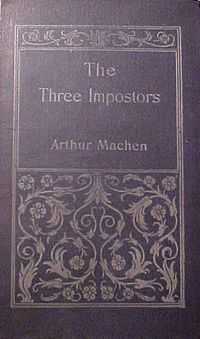The Three Impostors
|
Cover of The Three Impostors | |
| Author | Arthur Machen |
|---|---|
| Country | United Kingdom |
| Language | English |
| Genre | Horror novel |
| Publisher | John Lane |
Publication date | 1895 |
| Media type | Print (Hardback) |
| Pages | 215 pp |
| ISBN | NA |
The Three Impostors is an episodic novel by British horror fiction writer Arthur Machen, first published in 1895 in The Bodley Head's Keynote Series. Its importance was recognized in its later revival in paperback by Ballantine Books as the forty-eighth volume of the celebrated Ballantine Adult Fantasy series in June 1972.
Controversy
Publisher John Lane, wary of the atmosphere following the trial of Oscar Wilde, asked Machen to censor his manuscript. Barring the omission of one word, Machen refused to comply.[1]
Structure
The novel incorporates several inset weird tales and culminates in a final denouement of deadly horror, connected with a secret society devoted to debauched pagan rites. The three impostors of the title are members of this society who weave a web of deception in the streets of London—retailing the aforementioned weird tales in the process—as they search for a missing Roman coin commemorating an infamous orgy by the Emperor Tiberius and close in on their prey: "the young man with spectacles".[2]
Machen's later reflections on the novel
Partly in response to criticism of the Stevensonian style of the book, Machen altered his approach in writing his next book, The Hill of Dreams. Following the death of his first wife in 1899, Machen developed a greater interest in the occult, joining the Hermetic Order of the Golden Dawn. He noted that a number of events in his life seemed to mirror events in The Three Impostors, most notably a conflict in the order between William Butler Yeats (a "young man with spectacles") and Aleister Crowley, which reached its height around this time. (These experiences are reflected on in Alan Moore's Snakes and Ladders.)
In Things Near and Far (1923) Machen wrote:
It was in the early spring of 1894 that I set about the writing of the said "Three Impostors," a book which testifies to the vast respect I entertained for the fantastic, "New Arabian Nights" manner of R. L. Stevenson, to those curious researches in the byways of London which I have described already, and also, I hope, to a certain originality of experiment in the tale of terror.
Influence
Two of the novel's inset tales, "The Novel of the Black Seal" and "The Novel of the White Powder", have been cited as major influences on the work of H. P. Lovecraft. In his survey Supernatural Horror in Literature, Lovecraft suggested that these stories "perhaps represent the highwater mark of Machen's skill as a terror-weaver".[3] They have been frequently anthologised.
"The Novel of the Black Seal" has been cited as a model for some of Lovecraft's best-known stories: "The Call of Cthulhu",[4] "The Dunwich Horror",[5] and "The Whisperer in Darkness".[6] The story also bears strong resemblance to Lovecraft's story "The Lurking Fear", which tells of a deformed humanoid race living in a rural region of the Catskill Mountains. "The Novel of the White Powder", which Lovecraft said "approaches the absolute culmination of loathsome fright",[7] is pointed to as an inspiration for Lovecraft's stories of bodily disintegration, such as "Cool Air" and "The Colour Out of Space".
The story "Rx... Death!" in Tales from the Crypt #20 is an adaptation of "The Novel of the White Powder," with the change made that the poisonous "medicine" contains digestive enzymes, rather than a witch's brew.
References
- ↑ "John Lane and Arthur Machen: A Correspondence" in Faunus: The Journal of the Friends of Arthur Machen, volume 16 (Summer 2007)
- ↑ Review of The Three Imposters, The Bookman, February 1896. Reprinted in Jason Colavito, A Hideous Bit of Morbidity: An Anthology of Horror Criticism from the Enlightenment to World War I (Jefferson, NC: McFarland, 2008), pp. 227–28. ISBN 978-0-7864-3968-3
- ↑ H. P. Lovecraft, Supernatural Horror in Literature (Dover, 1973), p. 92.
- ↑ S. T. Joshi and David E. Schultz, "Call of Cthulhu, The", An H. P. Lovecraft Encyclopedia, pp. 28–29.
- ↑ Robert M. Price, The Dunwich Cycle, pp. ix–x.
- ↑ Robert M. Price, The Hastur Cycle, pp. xi–xiii.
- ↑ Lovecraft, p. 93.
Bibliography
- Bleiler, Everett (1948). The Checklist of Fantastic Literature. Chicago: Shasta Publishers. p. 188.
- Machen, Arthur (2007). The Three Impostors. Mineola, New York: Dover Publications. ISBN 978-0-486-46052-9.
External links
- The Three Imposters; Project Gutenberg public domain text
- The Three Impostors; complete text
